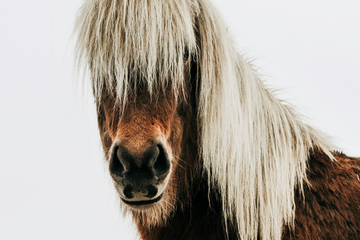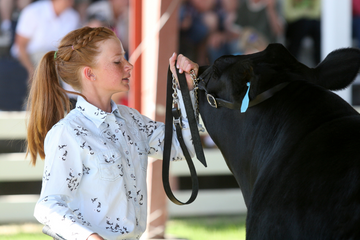 It is never too early to start thinking about blanketing your horse. Depending on the weather in your area, you might start blanketing sooner rather than later! Blanketing is a commonly discussed topic in the horse world with opinions on both sides. Blanketing has both positive and negative considerations.
One of the positive and most obvious aspects to blanketing your horse is the addition warmth blankets provide to your horse. If you are living in an extremely cold climate, a blanket will help to keep your horse warm through some of the coldest nights. They are also handy when a protective shelter is not available. Blankets are also used to keep horses clean. This makes the rider’s job much easier because blankets keep all of the mud, rain and snow off of a horse – allowing you to saddle up whenever you are ready to go! Blankets can also keep a show horse’s coat shorter throughout the winter, reducing the body clipping time used in the cooler months.
Some of the downsides to blankets are the dangers they can cause. A horse can easily get their legs tangled in the straps if a blanket is not fitted properly. Blankets can also cause hair to be rubbed off due to a misfit. Horses in temperatures that are not below 20 degrees Fahrenheit can do well without a blanket, provided they are given a lean-to or stalled during the coldest temperatures.
To find a blanket that properly fits your horse, you must first measure him/her. To properly measure your horse, start at the center of the chest, go around the shoulder, along the barrel (keeping close to the skin), along the flank, around the hip, to the center of the tail. The size of the blanket corresponds to inches. If you measure your horse at 80, your horse wears a size 80. If you measure an odd number, go up one inch. Blankets only come in even numbers.
A properly fitted blanket should allow four fingers at the chest and extend a few inches below the top of the tail. When fitting the leg straps on your horse, do not make them too tight as this can hinder your horse’s movement and will pull the blanket backwards, rubbing your horse’s chest. The straps should be intertwined to their respective sides, or crisscrossed.
Although it’s only October, start thinking about the pros and cons of blanketing your horse and make a decision if you will be doing it this year. It is always good to be prepared! We hope this blog, Winter Blanketing 101, was helpful and we encourage you to share it.
It is never too early to start thinking about blanketing your horse. Depending on the weather in your area, you might start blanketing sooner rather than later! Blanketing is a commonly discussed topic in the horse world with opinions on both sides. Blanketing has both positive and negative considerations.
One of the positive and most obvious aspects to blanketing your horse is the addition warmth blankets provide to your horse. If you are living in an extremely cold climate, a blanket will help to keep your horse warm through some of the coldest nights. They are also handy when a protective shelter is not available. Blankets are also used to keep horses clean. This makes the rider’s job much easier because blankets keep all of the mud, rain and snow off of a horse – allowing you to saddle up whenever you are ready to go! Blankets can also keep a show horse’s coat shorter throughout the winter, reducing the body clipping time used in the cooler months.
Some of the downsides to blankets are the dangers they can cause. A horse can easily get their legs tangled in the straps if a blanket is not fitted properly. Blankets can also cause hair to be rubbed off due to a misfit. Horses in temperatures that are not below 20 degrees Fahrenheit can do well without a blanket, provided they are given a lean-to or stalled during the coldest temperatures.
To find a blanket that properly fits your horse, you must first measure him/her. To properly measure your horse, start at the center of the chest, go around the shoulder, along the barrel (keeping close to the skin), along the flank, around the hip, to the center of the tail. The size of the blanket corresponds to inches. If you measure your horse at 80, your horse wears a size 80. If you measure an odd number, go up one inch. Blankets only come in even numbers.
A properly fitted blanket should allow four fingers at the chest and extend a few inches below the top of the tail. When fitting the leg straps on your horse, do not make them too tight as this can hinder your horse’s movement and will pull the blanket backwards, rubbing your horse’s chest. The straps should be intertwined to their respective sides, or crisscrossed.
Although it’s only October, start thinking about the pros and cons of blanketing your horse and make a decision if you will be doing it this year. It is always good to be prepared! We hope this blog, Winter Blanketing 101, was helpful and we encourage you to share it.
Blog
Winter Blanketing 101

 It is never too early to start thinking about blanketing your horse. Depending on the weather in your area, you might start blanketing sooner rather than later! Blanketing is a commonly discussed topic in the horse world with opinions on both sides. Blanketing has both positive and negative considerations.
One of the positive and most obvious aspects to blanketing your horse is the addition warmth blankets provide to your horse. If you are living in an extremely cold climate, a blanket will help to keep your horse warm through some of the coldest nights. They are also handy when a protective shelter is not available. Blankets are also used to keep horses clean. This makes the rider’s job much easier because blankets keep all of the mud, rain and snow off of a horse – allowing you to saddle up whenever you are ready to go! Blankets can also keep a show horse’s coat shorter throughout the winter, reducing the body clipping time used in the cooler months.
Some of the downsides to blankets are the dangers they can cause. A horse can easily get their legs tangled in the straps if a blanket is not fitted properly. Blankets can also cause hair to be rubbed off due to a misfit. Horses in temperatures that are not below 20 degrees Fahrenheit can do well without a blanket, provided they are given a lean-to or stalled during the coldest temperatures.
To find a blanket that properly fits your horse, you must first measure him/her. To properly measure your horse, start at the center of the chest, go around the shoulder, along the barrel (keeping close to the skin), along the flank, around the hip, to the center of the tail. The size of the blanket corresponds to inches. If you measure your horse at 80, your horse wears a size 80. If you measure an odd number, go up one inch. Blankets only come in even numbers.
A properly fitted blanket should allow four fingers at the chest and extend a few inches below the top of the tail. When fitting the leg straps on your horse, do not make them too tight as this can hinder your horse’s movement and will pull the blanket backwards, rubbing your horse’s chest. The straps should be intertwined to their respective sides, or crisscrossed.
Although it’s only October, start thinking about the pros and cons of blanketing your horse and make a decision if you will be doing it this year. It is always good to be prepared! We hope this blog, Winter Blanketing 101, was helpful and we encourage you to share it.
It is never too early to start thinking about blanketing your horse. Depending on the weather in your area, you might start blanketing sooner rather than later! Blanketing is a commonly discussed topic in the horse world with opinions on both sides. Blanketing has both positive and negative considerations.
One of the positive and most obvious aspects to blanketing your horse is the addition warmth blankets provide to your horse. If you are living in an extremely cold climate, a blanket will help to keep your horse warm through some of the coldest nights. They are also handy when a protective shelter is not available. Blankets are also used to keep horses clean. This makes the rider’s job much easier because blankets keep all of the mud, rain and snow off of a horse – allowing you to saddle up whenever you are ready to go! Blankets can also keep a show horse’s coat shorter throughout the winter, reducing the body clipping time used in the cooler months.
Some of the downsides to blankets are the dangers they can cause. A horse can easily get their legs tangled in the straps if a blanket is not fitted properly. Blankets can also cause hair to be rubbed off due to a misfit. Horses in temperatures that are not below 20 degrees Fahrenheit can do well without a blanket, provided they are given a lean-to or stalled during the coldest temperatures.
To find a blanket that properly fits your horse, you must first measure him/her. To properly measure your horse, start at the center of the chest, go around the shoulder, along the barrel (keeping close to the skin), along the flank, around the hip, to the center of the tail. The size of the blanket corresponds to inches. If you measure your horse at 80, your horse wears a size 80. If you measure an odd number, go up one inch. Blankets only come in even numbers.
A properly fitted blanket should allow four fingers at the chest and extend a few inches below the top of the tail. When fitting the leg straps on your horse, do not make them too tight as this can hinder your horse’s movement and will pull the blanket backwards, rubbing your horse’s chest. The straps should be intertwined to their respective sides, or crisscrossed.
Although it’s only October, start thinking about the pros and cons of blanketing your horse and make a decision if you will be doing it this year. It is always good to be prepared! We hope this blog, Winter Blanketing 101, was helpful and we encourage you to share it.





















